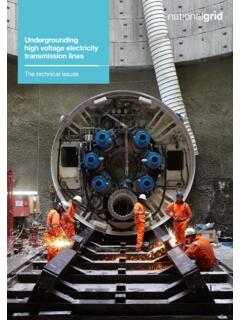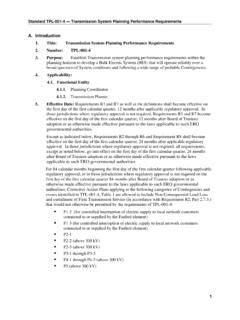Transcription of Fast payments - Enhancing the speed and availability of ...
1 Committee on payments and Market Infrastructures fast payments Enhancing the speed and availability of retail payments November 2016 This publication is available on the BIS website ( ). Bank for International Settlements 2016. All rights reserved. Brief excerpts may be reproduced or translated provided the source is stated. ISBN 978-92-9259-002-4 (print) ISBN 978-92-9259-003-1 (online) CPMI fast payments November 2016 iii Contents Acronyms and abbreviations .. iv Executive summary .. 1 1. Introduction .. 3 2. fast payments : Key definitions and 6 Definitions .. 6 Important additional characteristics of fast payment implementations .. 10 3. The development of fast payments .. 19 fast payments in the context of the broader payment system .. 19 Advances in information technology as a fundamental driver of fast payments .. 21 Potential obstacles related to the implementation of fast payments .
2 25 Forces related to the implementation of fast payments .. 28 The organisation of fast payments provision in a jurisdiction .. 31 4. Clearing and settlement issues in fast payment systems .. 33 fast payments processing models .. 34 Implications of different models of settlement for fast payments .. 41 5. Benefits and risks of fast payments .. 45 Benefits of fast payments to different parties .. 45 Impact of fast payments on risk .. 47 6. Issues related to fast payments .. 52 Issues generally relevant for stakeholders and authorities .. 52 Issues for central banks .. 57 7. Conclusions .. 70 Annexes .. 71 iv CPMI fast payments November 2016 Acronyms and abbreviations 24/7 24-hour and seven-day AML anti-money laundering ATM automated teller machine B2B business-to-business B2P business-to-person CFT countering/combating the financing of terrorism CPMI Committee on payments and Market Infrastructures CPSS Committee on Payment and Settlement Systems (now CPMI)
3 DNS deferred net settlement e-money electronic money EU European Union FMI financial market infrastructure IOSCO International Organization of Securities Commissions ISO International Organization for Standardization IT information technology KYC know your customer P2B person-to-business P2G person-to-government P2P person-to-person PFMI Principles for Financial Market Infrastructures POS point of sale PSP payment service provider RTGS real-time gross settlement SEPA Single Euro payments Area CPMI fast payments November 2016 1 Executive summary Over the last decade, fast retail payment services have been deployed (or are being developed) in many jurisdictions. fast payments can be defined by two key features: speed and continuous service availability . Based on these features, fast payments can be defined as payments in which the transmission of the payment message and the availability of final funds to the payee occur in real time or near-real time and on as near to a 24-hour and 7-day (24/7) basis as possible.
4 Because these types of service are significant innovations in the market for retail electronic payment services, and as their deployment may require substantial changes and investments in retail payments infrastructure, the Committee on payments and Market Infrastructures (CPMI) launched a study to investigate their development and importance. This report, prepared by the CPMI Working Group on Retail payments , characterises fast payments , takes stock of the different initiatives in various jurisdictions (see Annex 2 for a high-level summary), analyses supply and demand factors that may foster or hinder their development, details the main benefits and risks they may bring about and, finally, analyses potential implications for different stakeholders, with a particular focus on central banks. The emergence of fast payments in many CPMI jurisdictions, as well as the apparently accelerating rate of new proposals and implementations, reflects important developments in the demand for and supply of such payments .
5 Advances in information technology, including the spread of advanced mobile communications devices, have lowered costs for end users and payment service providers, making the provision and use of fast payments increasingly viable. In addition, these advances have served to alter end-user expectations for the speed and convenience of payments . On the one hand, investment costs, and the need for coordinated action by industry participants to achieve a critical mass of end users and sufficient scale of transactions may impede the implementation of fast payments . On the other, implementation has been favoured by competitive pressures, as well as action by authorities, including some central banks. The scope and timing of implementation, as well as the characteristics of specific services, schemes and systems, vary across CPMI jurisdictions, indicating that different environments and needs may continue to influence when and in what form fast payments emerge.
6 The Working Group found that fast payment services have the potential to generate benefits for various stakeholders and for society in general, provided that risks are properly managed. The clearest benefit of fast payments from an end-user perspective is the ability to complete time-sensitive payments quickly, wherever and whenever necessary. fast payments may also provide broader benefits for end users; although many of the additional benefits are not unique to fast payments , the implementation of fast payments is usually associated with the development of new infrastructure, which may be designed with these potential benefits in mind. As a result, the implementation of fast payments may accompany or provide the basis for service enhancements and value added services. Overall, the speed and enhanced service availability of fast payments , as well as any new functionalities, may meet the new expectations and needs of end users that rapid changes in technology, such as the spread of advanced mobile communications devices, have evoked.
7 Taking this into account, fast payments are of strategic importance for the long-run modernisation of the payment system . fast payments generally do not introduce new types of risk beyond those identified in previous reports as relevant for retail payments . However, the extent to which fast payments exacerbate some risks may warrant attention. Any incremental risks associated with fast payments need to be appropriately and effectively mitigated. An area that merits particular attention is the management of financial risks between payment service providers (PSPs) when settlement between PSPs is deferred; because a fast payment provides immediate final funds to the payee, deferred settlement between PSPs implies an extension of credit from the payee s PSP to the payer s PSP. Various measures can be taken to mitigate credit risks due to deferred settlement, and some fast payment implementations involve real-time settlement between PSPs, avoiding this risk altogether.
8 2 CPMI fast payments November 2016 From the perspective of end users, fast payments will likely provide new and more flexible capabilities for making retail payments quickly and with finality. As schemes, systems and PSPs make these capabilities available to the general public, there may be a need to focus on transparency and education with respect to new capabilities and risks, as well as rights, responsibilities and protections. The introduction of fast payments may also warrant a review of the adequacy of security arrangements, fraud mitigation mechanisms and, in some jurisdictions, consumer protection frameworks. The implementation of fast payment services is a complex endeavour involving many stakeholders. fast payment services can be offered along a spectrum of models from several competitive and interoperable systems, working under one or various schemes, to more centralised approaches where a single infrastructure clears and settles various payment methods serving various use cases.
9 Because of this complexity and the strategic importance of fast payments , a number of key considerations may arise: (i) A coordinated effort by many or most PSPs in a jurisdiction, resulting in interconnection between those PSPs and existing or enhanced core clearing and settlement systems, may improve the likelihood of achieving a large network of end users in a jurisdiction. Broad coverage of end users is important to realising the benefits of these payment services, which have strong network effects, and, as a result, may increase the likelihood that a fast payment implementation will be successful. (ii) Implementation costs may materialise in the short run whereas potential benefits for PSPs may only be reaped in the long term and could be difficult to quantify. For this reason, PSPs and other stakeholders should be encouraged to evaluate the potential benefits of fast payments (such as the scope for improving their service offerings and anticipating customer needs, or the prospect for future innovation based on fast payment platforms and functionality) over a long time horizon and to consider adopting a strategic view of the implementation of fast payments that takes such long-run factors into account The complexity of implementation increases in the case of cross-border initiatives.
10 Especially in this case, harmonised procedures and rules as well as technical and operational standards could facilitate the interoperability of different fast payment implementations. Central banks and other authorities may play a critical role in fostering the modernisation of payment systems in order to meet the public policy objectives of safety, efficiency and meeting end-user needs and expectations. Central banks, in particular, may contribute to the development and implementation of fast payments in their traditional roles as catalysts for change, as well as operators and overseers of payment systems, to the extent that fast payments contribute to meeting these public policy objectives. The role of central banks as operators of real-time gross settlement (RTGS) systems and providers of other types of settlement service is particularly relevant. Even if the central bank is not directly involved in the operation of a retail infrastructure processing fast payments , the provision of settlement services (via the RTGS system or other specialised settlement services) may be critical for the implementation of fast payments .

















